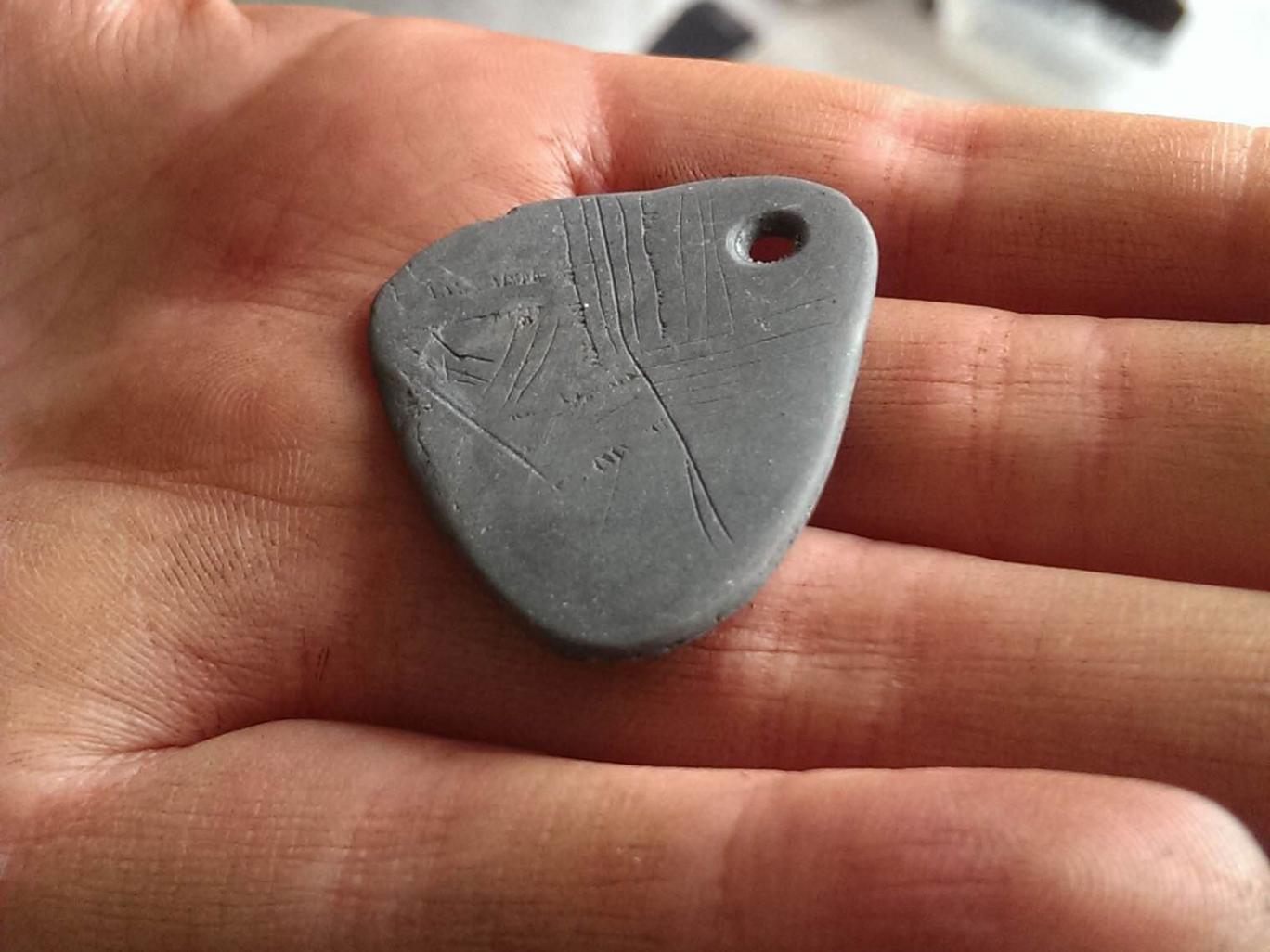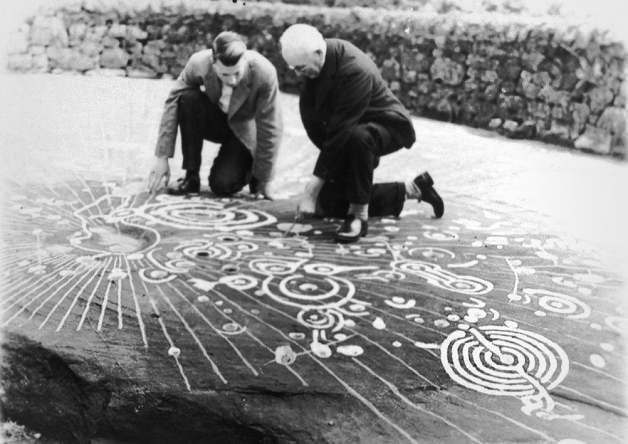It looks like you're using an Ad Blocker.
Please white-list or disable AboveTopSecret.com in your ad-blocking tool.
Thank you.
Some features of ATS will be disabled while you continue to use an ad-blocker.
17
share:

An 11,000 year old engraved shale pendant discovered by archaeologists during excavations at the Early Mesolithic site at Star Carr in North Yorkshire is unique in the UK, according to new research.
The artwork on the tiny fragile pendant, uncovered by a research team from the Universities of York, Manchester and Chester, is the earliest known Mesolithic art in Britain. Crafted from a single piece of shale, the subtriangular three-millimetre thick artefact measuring 31mm by 35mm contains a series of lines which archaeologists believe may represent a tree, a map, a leaf or even tally marks. Engraved motifs on Mesolithic pendants are extremely rare and no other engraved pendants made of shale are known in Europe. When archaeologists uncovered the pendant last year, the lines on the surface were barely visible. The research team used a range of digital microscopy techniques to generate high resolution images to help determine the style and order of engraving. They also carried out scientific analysis to try to establish if the pendant had been strung or worn and whether pigments had been used to make the lines more prominent. The research, which is part of a five-year project supported by the European Research Council, is published in Internet Archaeology. The research is also supported by Historic England and the Vale of Pickering Research Trust. The pendant is to be showcased to the public for the first time in a display at the Yorkshire Museum in York on 27 February until 5 May. Star Carr is one of a number of archaeological sites around what was the location of a huge lake which covered much of the Vale of Pickering in the Mesolithic era. Researchers discovered the pendant in lake edge deposits. Initially they thought it was natural stone—the perforation was blocked by sediment and the engravings were invisible. It is the first perforated artefact with engraved design discovered at Star Carr though shale beads, a piece of perforated amber and two perforated animal teeth have been recovered from the site previously.
Read more at: archaeologynewsnetwork.blogspot.jp...
Follow us: @ArchaeoNewsNet on Twitter | groups/thearchaeologynewsnetwork/ on Facebook
"One possibility is that the pendant belonged to a shaman—headdresses made out of red deer antlers found nearby in earlier excavations are thought to have been worn by shamans. We can only guess what the engravings mean but engraved amber pendants found in Denmark have been interpreted as amulets used for spiritual personal protection."
If I had saw the pendent on a less known site or blog I might have been tempted to dismiss it at a glance , because it looked somewhat like stuff Klaus Dona put out, and I am not making any connections here but this is the same era of Gobekli Tepe just noting the wavy lines on the pendant as on the monument, but more than likely it's not a thing, middle stone aged folks are proving to be more interesting than I ever thought.
It's actually an ancient lottery ticket, and they won!!!!!
Cool find!
Cool find!
Look at this! Feel the quality of that, that's craftsmanship
Ehm...all right, two points, ahm...two flats and a packet of gravel.
Ehm...all right, two points, ahm...two flats and a packet of gravel.
a reply to: Spider879
Easy to carry securely on a journey and similar but more evolved markings on standing stones and outcrops are thought by some to be maps.

Easy to carry securely on a journey and similar but more evolved markings on standing stones and outcrops are thought by some to be maps.

www.bradshawfoundation.com...
"Some people think that the Cochno Stone is a map showing the other settlements in the Clyde Valley - that's one of the theories. I think it was probably used for lots of things; it was never used for just one thing and over hundreds of years it changed use."
a reply to: Spider879
Isn't it gorgeous? And that it was found near antler head-dresses suggests a shamanic connection, which gives a fascinating insight into life in the Mesolithic area.
Given the effort the team went to to find the inscriptions, I wondered if there were more originally that simply got worn away?
a reply to: Kester
Hi Kester, my money's on a star map for the Cochno stone.
Isn't it gorgeous? And that it was found near antler head-dresses suggests a shamanic connection, which gives a fascinating insight into life in the Mesolithic area.
Given the effort the team went to to find the inscriptions, I wondered if there were more originally that simply got worn away?
a reply to: Kester
Hi Kester, my money's on a star map for the Cochno stone.
Its a guitar pick. they were giving "rock music" its name.
ba-dump-dump
ba-dump-dump
I'm going to scribble lines all outside the box on this.
We've found this "line writing" all across the earlier era's. It's too easy to pander to the idea of uneducated ancestors just scratching a living and grunting at each other.
My personal thoughts have always been that this line writing is a language, similar in type to the runes, maybe mnemonic in nature maybe not, but it's a defined language/set of symbols probably universal at the time by different cultures who traded, did business among all the tribes at that time.
Since it's found in all cultures, it'd be a mistake to try to isolate it and tag it only to one. By in all cultures I am referencing the circumpolar and north atlantic. Trade drove the economy at the time so it would stand to reason they would need a common communication method.
Just my thoughts.
We've found this "line writing" all across the earlier era's. It's too easy to pander to the idea of uneducated ancestors just scratching a living and grunting at each other.
My personal thoughts have always been that this line writing is a language, similar in type to the runes, maybe mnemonic in nature maybe not, but it's a defined language/set of symbols probably universal at the time by different cultures who traded, did business among all the tribes at that time.
Since it's found in all cultures, it'd be a mistake to try to isolate it and tag it only to one. By in all cultures I am referencing the circumpolar and north atlantic. Trade drove the economy at the time so it would stand to reason they would need a common communication method.
Just my thoughts.
a reply to: bigfatfurrytexan
I agree definitely a pick! And why not? Wood and sea lion strings wouldn't have survived.
I'll go and research that...
I agree definitely a pick! And why not? Wood and sea lion strings wouldn't have survived.
I'll go and research that...
new topics
-
Thousands Of Young Ukrainian Men Trying To Flee The Country To Avoid Conscription And The War
Other Current Events: 2 hours ago -
12 jurors selected in Trump criminal trial
US Political Madness: 5 hours ago -
Iran launches Retalliation Strike 4.18.24
World War Three: 5 hours ago -
Israeli Missile Strikes in Iran, Explosions in Syria + Iraq
World War Three: 6 hours ago -
George Knapp AMA on DI
Area 51 and other Facilities: 11 hours ago -
Not Aliens but a Nazi Occult Inspired and then Science Rendered Design.
Aliens and UFOs: 11 hours ago
top topics
-
George Knapp AMA on DI
Area 51 and other Facilities: 11 hours ago, 25 flags -
Israeli Missile Strikes in Iran, Explosions in Syria + Iraq
World War Three: 6 hours ago, 14 flags -
Louisiana Lawmakers Seek to Limit Public Access to Government Records
Political Issues: 14 hours ago, 7 flags -
So I saw about 30 UFOs in formation last night.
Aliens and UFOs: 17 hours ago, 6 flags -
Iran launches Retalliation Strike 4.18.24
World War Three: 5 hours ago, 6 flags -
Not Aliens but a Nazi Occult Inspired and then Science Rendered Design.
Aliens and UFOs: 11 hours ago, 5 flags -
12 jurors selected in Trump criminal trial
US Political Madness: 5 hours ago, 4 flags -
The Tories may be wiped out after the Election - Serves them Right
Regional Politics: 15 hours ago, 3 flags -
Thousands Of Young Ukrainian Men Trying To Flee The Country To Avoid Conscription And The War
Other Current Events: 2 hours ago, 3 flags
active topics
-
Thousands Of Young Ukrainian Men Trying To Flee The Country To Avoid Conscription And The War
Other Current Events • 1 • : stosh64 -
Mandela Effect - It Happened to Me!
The Gray Area • 108 • : ArMaP -
Mood Music Part VI
Music • 3058 • : Hellmutt -
Fossils in Greece Suggest Human Ancestors Evolved in Europe, Not Africa
Origins and Creationism • 60 • : whereislogic -
Scarface does Tiny Desk Concert
Music • 7 • : sitrose -
The Acronym Game .. Pt.3
General Chit Chat • 7727 • : F2d5thCavv2 -
Russia Ukraine Update Thread - part 3
World War Three • 5697 • : F2d5thCavv2 -
Do we live in a simulation similar to The Matrix 1999?
ATS Skunk Works • 22 • : SchrodingersRat -
Iran launches Retalliation Strike 4.18.24
World War Three • 15 • : semperfortis -
President BIDEN Warned IRAN Not to Attack ISRAEL - Iran Responded with a Military Attack on Israel.
World War Three • 43 • : WeMustCare
17
